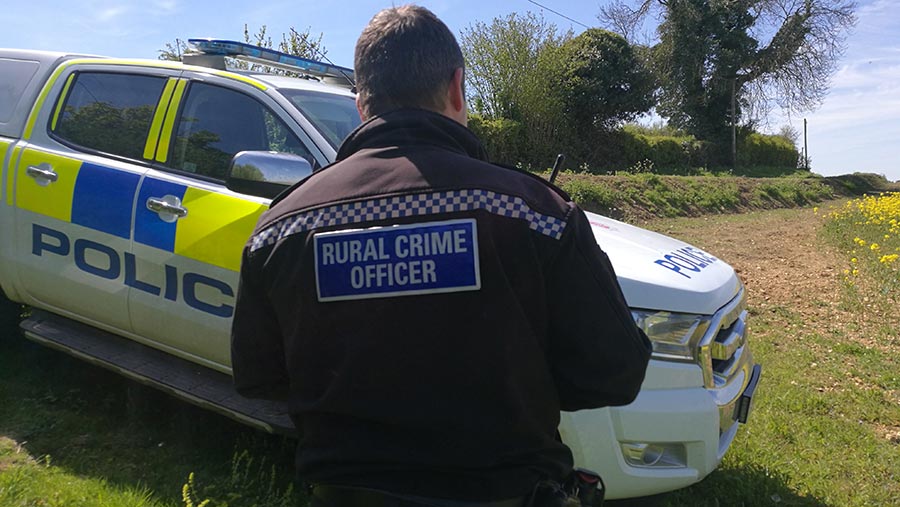Cost of rural crime rises at fastest rate for seven years
 © Philip Case/Proagrica
© Philip Case/Proagrica The cost of rural theft has risen to £50m as organised criminals gangs target machinery and livestock, according to latest claims statistics from rural insurer, NFU Mutual.
Farmers are deploying high-tech security devices to counter a wave of organised theft in the countryside.
Police are also using technology to catch rural criminals, including operating drones during investigations and using social media networks to share real-time intelligence with rural communities.
See also: Exclusive survey – What farmers say about rural crime
NFU Mutual, which provides insurance for farmers and landowners, released its annual rural crime report this morning (5 August).
It shows that the cost of rural crime in 2018 rose by 12% on the previous year, to its highest level since 2011.
While the cost of rural crime fell in two regions – by 7% in Wales and 1% in the the South West – the biggest increases were recorded in Scotland (62%), north-east England (25%) and East Anglia (22%).
The sharp rises are being driven mainly by high-value thefts of tractors, quad bikes and other farm vehicles – up 26% to £7.4m in 2018.
Criminal gangs
Tim Price, rural affairs specialist at NFU Mutual, said that while many farmers were taking action to prevent rural crime, criminal gangs with links to money laundering and drugs were finding ways to beat security and steal farm vehicles.
“In a single generation, country people have seen rural crime change from the opportunist theft of a single lamb, to brazen heists of tractors worth over £100,000 and rustlers stealing hundreds of sheep,” he said.
Across the country agricultural vehicles are being stolen to smash into village shops to rob cash machines.
Farms in isolated locations are suffering from repeated thefts of machinery, raids on tool stores, and sheep being stolen or illegally butchered for their meat in the fields.
Thieves come armed with battery-powered angle grinders which can cut through chains and padlocks in seconds to access farm buildings and tool sheds.
Taking action
But farmers are using a range of innovative measure to protect their fields and farmyards.
These include infrared intruder alerts in farmyards which send messages to mobile phones when triggered; geo-fencing, which triggers an alarm if a tractor is taken beyond the farm boundary, and livestock marking which puts thousands of coded micro-dots into fleeces.
As featured in Farmers Weekly in May, farmers in Gloucestershire are building earth bunds around fields to protect crops and keep criminals off land.
The NFU Mutual report found that fear of crime is changing life in the countryside, and country people feel they are under siege. This is supported by an April Farmers Weekly survey on rural crime when 78% or respondents said they were concerned about becoming a victim.
“Some farmers are so concerned about the risk of criminal attack they can no longer leave the farm with their family to attend local events,” Mr Price said.
Rural Crime Trends
Quad bikes and ATVs
• Quads and all-terrain vehicles (ATVs) are disappearing from farms in large numbers – they are favoured by criminals because they are easy to transport and often don’t have registration plates.
• The cost of quad and ATV theft claims to NFU Mutual rose from £2.3m in 2017 to £2.6m in 2018 – a 10% increase.
• Bespoke physical security devices, such as the Quad Vice, can deter all but the most determined thieves.
• CESAR marking and tracking devices are the most effective security measures, once basic measures have been addressed such as keeping vehicles secured and out of sight in a building.
Tractors
• The cost of agricultural vehicle theft claims to NFU Mutual rose by 26% to £7.4m in 2018 from £5.9m in 2017.
• Thieves are increasingly cloning the identities of tractors to make detection more difficult.
• Thieves are stealing expensive tractors costing more than £50,000 for export to developed counties, and small, older tractors to export to less affluent markets.
• NFU Mutual goes to extreme lengths to trace and recover tractors which have been stolen and exported, to send a strong message to thieves.
Livestock
• The cost of livestock theft reported to NFU Mutual increased by 3.7% to £2.5m in 2018 from £2.4m in 2017.
• Technology – including DNA testing and recording, fleece marking with micro-dots, electronic chips and boluses – now offers robust evidence to help bring rustlers to justice.
• Thefts of large numbers of lambs are raising concerns that stock is being stolen for slaughter and processing outside the regulated abattoirs before illegally entering the food chain.
Source: NFU Mutual Rural Crime Report 2019
